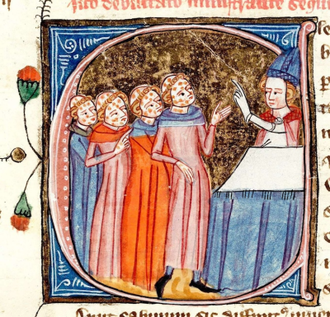Gospel in Art: A leper came to Jesus, imploring him

Leprosy victims taught by a bishop, Medieval Illumination by James Le Palmer, from the Omne Bonum manuscript,1360-1375, Record Number: c6541-07; Royal 6 E. VI; f.301ra.
Source: Christian Art
Gospel of 16 January 2025
Mark 1:40-45
At that time: A leper came to Jesus, imploring him, and kneeling said to him, 'If you will, you can make me clean.' Moved with pity, he stretched out his hand and touched him and said to him, 'I will; be clean.' And immediately the leprosy left him, and he was made clean. And Jesus sternly charged him and sent him away at once, and said to him, 'See that you say nothing to anyone, but go, show yourself to the priest and offer for your cleansing what Moses commanded, for a proof to them.' But he went out and began to talk freely about it, and to spread the news, so that Jesus could no longer openly enter a town, but was out in desolate places, and people were coming to him from every quarter.
Reflection on the Illuminated Manuscript
The author of the text Omne Bonum described his monumental work as containing "virtually all good things." This vast encyclopaedia, compiled and transcribed by James le Palmer, aimed to gather the knowledge of the time into a single, comprehensive reference. Organised alphabetically according to the medieval Latin alphabet, it was designed to aid "simple individuals who wish to seek out the precious pearls of learning."
The encyclopaedia consists of 1,350 entries spread across 23 books, corresponding to the alphabet. Over 750 of these entries are adorned with historiated initials, richly illustrating the text and enhancing its accessibility. Spanning 1,094 pages, Omne Bonum is preserved in two volumes, each surviving in two parts, and is now housed at the British Library. This remarkable manuscript stands as a testament to the intellectual ambitions of its age. The illustrations are a gold mine of visual information about the medieval world. Our illustration is one of the many biblical illustrations. It depicts lepers standing in front of a bishop, thus tying the healing of the lepers by Jesus to episcopal responsibilities of the time. In the Middle Ages, leprosy still could not be cured. It was as contagious as in ancient times. So today's Gospel reading would still have resonated a great deal with 13th/14th century people. Hence, leprosy is very present in Medieval art.
The key to today's Gospel reading is that Jesus actually touches the leper to heal him. In many of his healings, Jesus does not always lay hands on those he cures, so the fact that Mark specifically highlights this in his Gospel suggests a deeper significance. In Jesus' time, lepers were shunned, often forced to live outside the cities and away from society. Physical contact with a leper not only carried the perceived risk of disease but also resulted in ritual impurity, alienating anyone who touched them from the wider community. Jesus, however, overturns this perception. By reaching out and touching the leper, he demonstrates that his divine power works in the opposite way. Rather than becoming unclean himself, he makes the leper clean, restoring not only his physical health but also his place in the community. Through Jesus' touch, the barriers of exclusion and impurity are broken.
LINKS
Gospel in Art: https://christian.art/
Today's Reflection: https://christian.art/daily-gospel-reading/mark-1-40-45-2025/


















